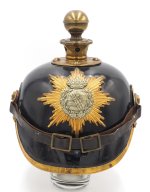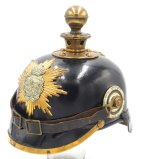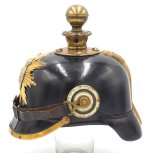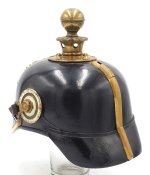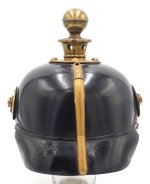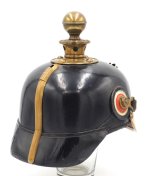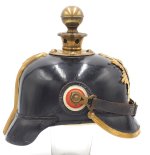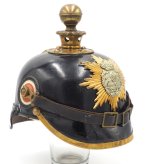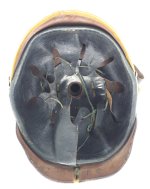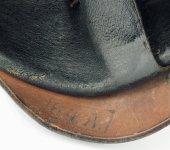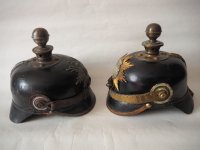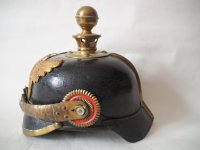You are using an out of date browser. It may not display this or other websites correctly.
You should upgrade or use an alternative browser.
You should upgrade or use an alternative browser.
Pickelhaube from the Kgl. Sächs. 5. Feld-Artillerie-Regt. Nr.64?
- Thread starter FRONTENAC
- Start date
dixmude 14
Member
magnifique
pickelhauben
Well-known member
Looks perfect !
Naprawiacz
Well-known member
It makes me wonder rear spine shouldn't be different?
Sandmann
Well-known member
Wojtek, it was the same as in Prussia. Only the M1895 helmet of the Field-Artillery was equipped with a rear spine without ventilation. The Foot-Artillery, however, wore a M1895 helmet with ventilation. You can read this in the Saxon clothing regulations for enlisted men from 1904, which I can provide you if you are interested.It makes me wonder rear spine shouldn't be different?
Naprawiacz
Well-known member
Thank you beautifully Sandy for the valuable lesson! A man learns all his life.Greetings warmly.Wojtek, it was the same as in Prussia. Only the M1895 helmet of the Field-Artillery was equipped with a rear spine without ventilation. The Foot-Artillery, however, wore a M1895 helmet with ventilation. You can read this in the Saxon clothing regulations for enlisted men from 1904, which I can provide you if you are interested.
CLOVIS 57
Well-known member
I agree with Sandy.
In summary, very quickly, the problem arose of perspiration of the scalp in the helmets of the troops on foot. (unlike mounted troops). Thus, from 2 holes in the M67 tip, we went to 4 or 5 holes for everyone (except officers) and that an additional vent was made in the rear spine on the M95. (always except for officers).
Thus, infantry, Engineers, heavy and foot artillery and other foot troops (the Train is considered on foot) => flap vent
---Dragons, Chevaulegers, mounted artillery (FieldArtillery) no flap and vent on rear spine.
In summary, very quickly, the problem arose of perspiration of the scalp in the helmets of the troops on foot. (unlike mounted troops). Thus, from 2 holes in the M67 tip, we went to 4 or 5 holes for everyone (except officers) and that an additional vent was made in the rear spine on the M95. (always except for officers).
Thus, infantry, Engineers, heavy and foot artillery and other foot troops (the Train is considered on foot) => flap vent
---Dragons, Chevaulegers, mounted artillery (FieldArtillery) no flap and vent on rear spine.
CLOVIS 57
Well-known member
I continue :
---The Feld-Artillery was the hypomobile artillery in 14, which accompanied the line infantry.
--- Foot artillery was heavy artillery, siege artillery, fortress artillery, or rail-mounted naval artillery. Position artillery was much less mobile.
--- Given the above:
In theory :
--- There were 84 field artillery regiments with no air flaps on the rear spine (and bulging scales on the jugular).
---There were 17 Artillery-Regiment on foot with ventilation flap on the column (and flat scales on the jugular)
Frontenac
Nice helmet.
But, Fiel-Artillerie 64, regulations should have the rear spine without an aerator. My Saxon foot artillery helmet N°12 (METZ garrison in the Reichsland) for example is correct.
This anomaly is explained once again by an emergency assembly of the mobilization where the regulatory standard was no longer respected given the circumstances and the urgency. This is how (as Sandy says) your helmet no longer has the small format side visor rivets, but the rivet heads normally used for attaching the base of the visor.
---The Feld-Artillery was the hypomobile artillery in 14, which accompanied the line infantry.
--- Foot artillery was heavy artillery, siege artillery, fortress artillery, or rail-mounted naval artillery. Position artillery was much less mobile.
--- Given the above:
In theory :
--- There were 84 field artillery regiments with no air flaps on the rear spine (and bulging scales on the jugular).
---There were 17 Artillery-Regiment on foot with ventilation flap on the column (and flat scales on the jugular)
Frontenac
Nice helmet.
But, Fiel-Artillerie 64, regulations should have the rear spine without an aerator. My Saxon foot artillery helmet N°12 (METZ garrison in the Reichsland) for example is correct.
This anomaly is explained once again by an emergency assembly of the mobilization where the regulatory standard was no longer respected given the circumstances and the urgency. This is how (as Sandy says) your helmet no longer has the small format side visor rivets, but the rivet heads normally used for attaching the base of the visor.
Last edited:
CLOVIS 57
Well-known member
Infra, in photo:
2 Artillerie-zu-Fuß, of the 12th Saxon regiment based in Metz. Both are correct on the aerator point. Model 15 shows good visor rivets, while the mobilization M95 should have smaller visor rivets, and a campaign chinstrap, in leather... but at mobilization, we emptied the drawer bottoms !!
The Baden, shows an example of good F.A.R. but the roundel is a larger diameter Dragon roundel...but goes well with the scaled chinstrap. Here again the second choice of mobilization.
2 Artillerie-zu-Fuß, of the 12th Saxon regiment based in Metz. Both are correct on the aerator point. Model 15 shows good visor rivets, while the mobilization M95 should have smaller visor rivets, and a campaign chinstrap, in leather... but at mobilization, we emptied the drawer bottoms !!
The Baden, shows an example of good F.A.R. but the roundel is a larger diameter Dragon roundel...but goes well with the scaled chinstrap. Here again the second choice of mobilization.
Attachments
CLOVIS 57
Well-known member
THANKS.
As I do not master the English language well, I go through the Google translation. In case of misunderstanding, do not hesitate to ask me for clarification. For example, if I write a helmet "bomb" the translation is not good, and I have to write "shell" so that it can be understood in English.
As I do not master the English language well, I go through the Google translation. In case of misunderstanding, do not hesitate to ask me for clarification. For example, if I write a helmet "bomb" the translation is not good, and I have to write "shell" so that it can be understood in English.
argonne
Well-known member
Dear Cloclo, better use the deepl translator.
It´ s much much better!
Philippe
It´ s much much better!
Philippe
FRONTENAC
Well-known member
Merci Clovis!I continue :
---The Feld-Artillery was the hypomobile artillery in 14, which accompanied the line infantry.
--- Foot artillery was heavy artillery, siege artillery, fortress artillery, or rail-mounted naval artillery. Position artillery was much less mobile.
--- Given the above:
In theory :
--- There were 84 field artillery regiments with no air flaps on the rear spine (and bulging scales on the jugular).
---There were 17 Artillery-Regiment on foot with ventilation flap on the column (and flat scales on the jugular)
Frontenac
Nice helmet.
But, Fiel-Artillerie 64, regulations should have the rear spine without an aerator. My Saxon foot artillery helmet N°12 (METZ garrison in the Reichsland) for example is correct.
This anomaly is explained once again by an emergency assembly of the mobilization where the regulatory standard was no longer respected given the circumstances and the urgency. This is how (as Sandy says) your helmet no longer has the small format side visor rivets, but the rivet heads normally used for attaching the base of the visor.
Amybellars
Well-known member
The saxon helmet in discussion is on age of Kings website

